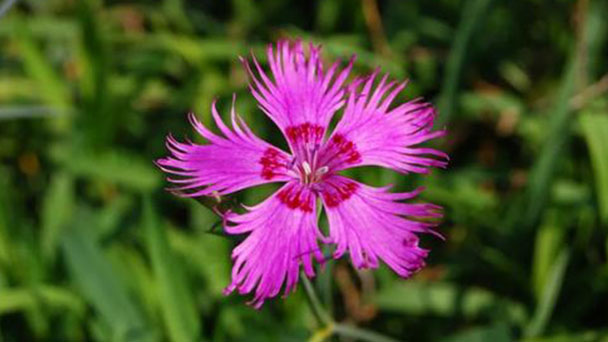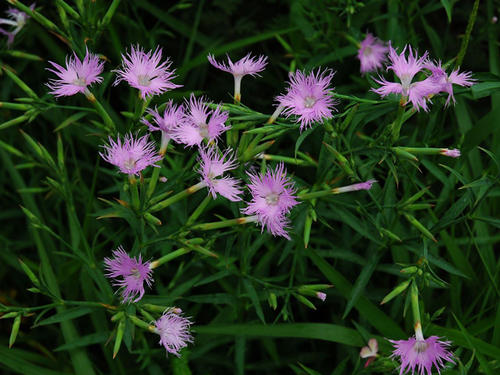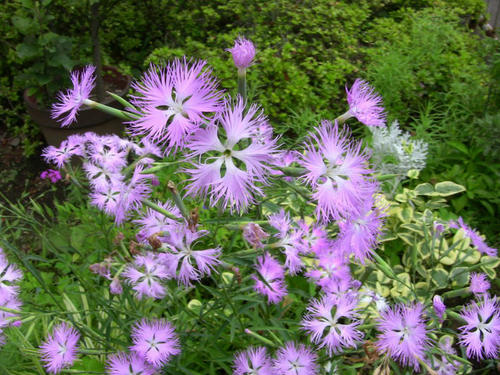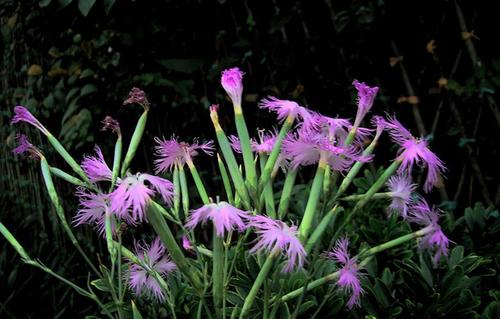Fringed pink profile
Written by Maggie
Jan 19 2021

The Fringed pink, scientific name Dianthus superbus, is a herbaceous species in the carnation family. The Fringed pink has some medicinal value and can be used as an ornamental flower to decorate the flower bed.
Fringed pink piture

Morphological characteristics of Fringed pink
The fringed pink is a perennial herb of the genus Caryophoraceae and Caryophora, with a height of 50-60 cm or more. Stems are caespitose, erect, green, glabrous, distally branched. Leaf-blade is linear-lanceolate, apex acute, midrib especially conspicuous, base connate sheathlike, green, sometimes pinkish green. Surrounded in calyx tube, valves broadly obovate, margin lobed to middle or above, usually pale red or purplish, watery white, throat with silky scales; Stamens and style are emarginate. The capsule is cylindrical, as long as the persistent calyx or slightly long, apical 4 lobed; Seeds are oblate ovoid, ca. 2 mm long, black, shiny.
The Fringed pink (flowering from June to September, fruiting from August to October).
The geographical distribution of Fringed pink
Fringed pink is produced in Northeast, North China, Northwest and Shandong, Jiangsu, Zhejiang, Jiangxi, Henan, Hubei, Sichuan, Guizhou, Xinjiang. It is also found in northern Europe, central Europe, Siberia, Kazakhstan, Mongolia (west and north), Korea, Japan. The type specimens were collected from Northern Lapland.
The Growing Habit of the Fringed pink
The Fringed pink is a simple and cultivated plant, which can be bred by sowing or dividing.
The Fringed pink has no high requirement on the soil. Usually, it will choose sandy soil with good drainage. Water is very important to the growth of Fringed pink. Be careful not to have too much water or too much water. Just make sure the water is suitable. Fertilizer is generally applied 3 times a year.

Growing methods of Fringed pink
The Fringed pink has strong adaptability. It used to be wild in grasslands and grass on hillsides, and it can be cultivated in soil without strict requirements. But with fertile sandy soil as well, the sex likes the warm and humid environment, afraid of drought, cold. Its seed reproduction in the spring, summer, autumn can be carried out, the best spring planting, when the choice of irrigation conditions, good drainage, fertile loose sandy soil, fertilizer, turn into the ground, prepare for the bed. The beds are 4-5 feet wide, 2-3 feet long, along the beds according to the row distance of 6-8 inches, row 1 cm trench, the seeds evenly scattered in the trench, and then covered with soil, step again with the foot. With iron rake hoping water, seven or eight days can emerge.
Field management
Seedlings after no seedlings, in the growing season, timely loosing soil weeding, watering, seedling height 3-4 inches, 15-25kg urea. Increase the number of watering appropriately before flowering, some ammonium sulfate or urea can be topdressing. Spring sowing, the next year can be harvested twice, before the harvest of a watering, two, three days after the acquisition of water, so as not to die. Topdressing should be carried out after each harvest when the seedling height is 2-3 inches. The fertilization method is the same as above. When freezing, cover some of the manure, and the second year when thawing, break the dung block huo flat, not only increase fertility but also improve the ground temperature.
Pest control
1. In high temperature and rainy season, low-lying water is easy to rot roots and dead seedlings, can be timely drainage flood control; 2. During the growth, there are green insects and sticky insects that harm the leaves. If found, it is necessary to spray 6% wettable 6666 powder in time, 2-3kg per acre of land.
Harvesting and processing
1. Seed selection and seed retention: when harvesting the first crop, wait until the fruit is ripe and then cut, pour out the seeds, remove impurities, for seed retention; 2. Harvest: Harvest twice a year, the first in Grain in Ear Festival, the second before the Start of Autumn after Major Heat, in the Cold Dew Festival, each time in most have been cultivated, a few long fruit horn is appropriate, too early will reduce the quality, too late will reduce the efficacy. After cutting, dried and bundled into a small bundle can be used, a continuous harvest of 5-6 years planting, high efficiency, per acre seed yield of 75kg.
The Value of Fringed pink
Cultivated as a potted flower or in a flowerbed, the Fringed pink has high Fringed qualities as a treatment for a wide variety of disorders. The Fringed pink can be made into a pesticide.

Latest Updated
- Benefits of Bugleweed - 7 Science-backed Health Benefits
- Bugleweed Dangers & Side Effects - Is It Poisonous?
- How to Plant Evergreen Trees - What You Should Know
- When to Plant Evergreens - Grow Guide for Evergreen Trees
- 12 Wonderful Evergreen Shrubs for Your Garden
- 12 Popular Evergreen Plants with Pictures for Beginners
- When And How To Prune A Lilac Bush Like a Pro
- How to Grow & Care for Lilac Vine (Hardenbergia Violacea)
- Japanese Lilac Tree (Syringa Reticulata) Care & Propagation Guide
- Shumard Oak Pros and Cons - What to Know
Popular Articles
- Winter maintenance of Antirrhinum Majus
- How to Grow Terminalia Mantaly Tree
- How to Grow and Care for Crossostephium Chinense
- How to grow Antirrhinum Majus in spring
- Peristeria Elata (Dove Orchid) Profile: Info & Care Guide
- Underwatered Snake Plant (Sansevieria Trifasciata) - Signs And How To Fix
- How to Care for Brazilian Jasmine Plant (Mandevilla Sanderi)
- How to Grow & Care for Graptopetalum Purple Delight in Summer
- Rosa Chinensis (China Rose): Plant Growing & Care Tips
- How to Care for Baby Sun Rose (Aptenia Cordifolia)